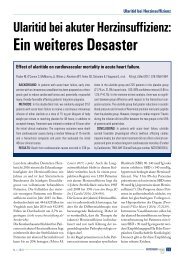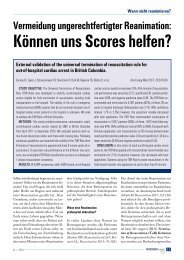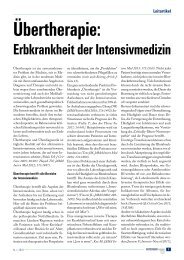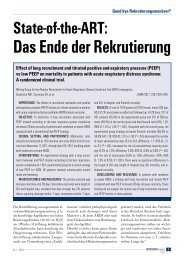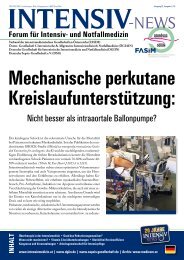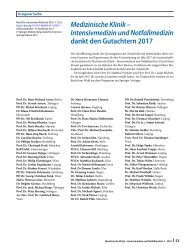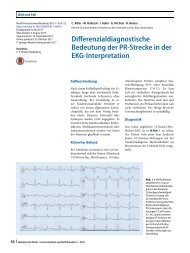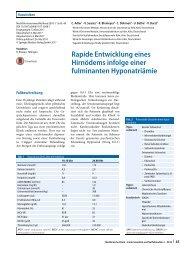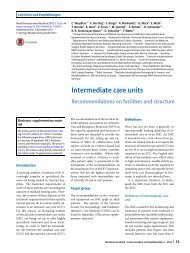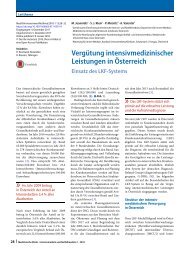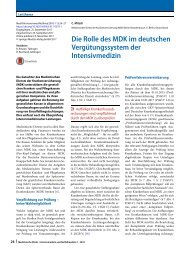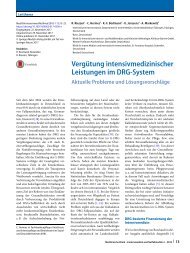Implantable Assist Devices
You also want an ePaper? Increase the reach of your titles
YUMPU automatically turns print PDFs into web optimized ePapers that Google loves.
When and who to<br />
refer for implantable<br />
assist devices.
§ The number of patients with advanced heart failure that has become<br />
unresponsive to conventional medical therapy is increasing rapidly.<br />
§ Patients with acute myocardial infarction complicated by acute heart<br />
failure or cardiogenic shock have high mortality with conventional<br />
therapy (10% -/- 50%).<br />
§ No other field in cardiology is experiencing such explosive growth as<br />
mechanical circulatory support for advanced heart failure (HF).<br />
§ To date, there are no guidelines for appropriate selection for use of<br />
these devices that are approved by national societies in the field.
Heart transplantation will never meet the demands<br />
2015<br />
JHLT. 2015 2014 Oct; 34(10): 33(10): 1244-1254 996-1008<br />
NOTE: This figure includes only the heart transplants<br />
that are reported to the ISHLT Transplant Registry. As<br />
such, the presented data may not mirror the changes in<br />
the number of heart transplants performed worldwide.
Heart transplantation will never meet the demands<br />
Patients to consider<br />
Contraindications<br />
§ End-stage HF with severe symptoms, a poor prognosis, and<br />
no remaining alternative treatment options.<br />
§ Motivated, well informed, and emotionally stable.<br />
§ Capable of complying with the intensive treatment required<br />
post-operatively.<br />
§ Active infection.<br />
§ Severe peripheral arterial or cerebrovascular disease.<br />
§ Pharmacologically irreversible pulmonary hypertension<br />
(LVAD should be considered with a subsequent reevaluation<br />
to establish candidacy).<br />
§ Cancer (a collaboration with oncology specialists should<br />
occur to stratify each patient as to their risk of tumour<br />
recurrence).<br />
§ Irreversible renal dysfunction (e.g. creatinine clearance 35 kg/m2 (weight loss is recommended<br />
to achieve a BMI
Heart transplantation will never meet the demands<br />
Patients to consider<br />
Contraindications<br />
§ End-stage HF with severe symptoms, a poor prognosis, and<br />
no remaining alternative treatment options.<br />
§ Motivated, well informed, and emotionally stable.<br />
§ Capable of complying with the intensive treatment required<br />
post-operatively.<br />
§ Active infection.<br />
§ Severe peripheral arterial or cerebrovascular disease.<br />
§ Pharmacologically irreversible pulmonary hypertension<br />
(LVAD should be considered with a subsequent reevaluation<br />
to establish candidacy).<br />
§ Cancer (a collaboration with oncology specialists should<br />
occur to stratify each patient as to their risk of tumour<br />
recurrence).<br />
§ Irreversible renal dysfunction (e.g. creatinine clearance 35 kg/m2 (weight loss is recommended<br />
to achieve a BMI
Heart transplantation will never meet the demands<br />
Patients to consider<br />
Contraindications<br />
§ End-stage HF with severe symptoms, a poor prognosis, and<br />
no remaining alternative treatment options.<br />
§ Motivated, well informed, and emotionally stable.<br />
§ Capable of complying with the intensive treatment required<br />
post-operatively.<br />
§ Active infection.<br />
§ Severe peripheral arterial or cerebrovascular disease.<br />
§ Pharmacologically irreversible pulmonary hypertension<br />
(LVAD should be considered with a subsequent reevaluation<br />
to establish candidacy).<br />
§ Cancer (a collaboration with oncology specialists should<br />
occur to stratify each patient as to their risk of tumour<br />
recurrence).<br />
§ Irreversible renal dysfunction (e.g. creatinine clearance 35 kg/m2 (weight loss is recommended<br />
to achieve a BMI
Bridge to decision (BTD)/<br />
Bridge to bridge (BTB)<br />
Bridge to candidacy (BTC)<br />
Bridge to transplantation<br />
(BTT)<br />
Bridge to recovery (BTR)<br />
Destination therapy (DT)<br />
INDICATIONS FOR VADs<br />
Use of short-term MCS (e.g. ECLS or ECMO) in patients with<br />
cardiogenic shock until haemodynamics and end-organ perfusion are<br />
stabilized, contra-indications for long-term MCS are excluded (brain<br />
damage after resuscitation) and additional therapeutic options<br />
including long-term VAD therapy or heart transplant can<br />
be evaluated.<br />
Use of MCS (usually LVAD) to improve end-organ function in order to<br />
make an ineligible patient eligible for heart transplantation.<br />
Use of MCS (LVAD or BiVAD) to keep patient alive who is otherwise<br />
at high risk of death before transplantation until a donor organ<br />
becomes<br />
available.<br />
Use of MCS (typically LVAD) to keep patient alive until cardiac function<br />
recovers sufficiently to remove MCS.<br />
Long-term use of MCS (LVAD) as an alternative to transplantation in<br />
patients with end-stage HF ineligible for transplantation or long-term<br />
waiting for heart transplantation.<br />
BiVAD = biventricular assist device; BTB = bridge to bridge; BTC = bridge to candidacy; BTD = bridge to decision; BTR = bridge to recovery;<br />
BTT = bridge to transplantation; DT = destination therapy; ECLS = extracorporeal life support; ECMO = extracorporeal membrane oxygenation;<br />
HF = heart failure; LVAD = left ventricular assist device; MCS = mechanical circulatory support; VAD = ventricular assist device<br />
European Heart Journal<br />
DOI:http://dx.doi.org/10.1093/eurheartj/ehw128 2129-2200 First<br />
published online: 20 May 2016
Recommendation Class Level Reference<br />
An LVAD should be considered in<br />
patients who have end- stage HFrEF<br />
despite optimal medical and device<br />
therapy and who are eligible for<br />
heart transplantation in order<br />
to improve symptoms, reduce the<br />
risk of HF hospitalization and the<br />
risk of premature death.<br />
(Bridge to transplant indication).<br />
An LVAD should be considered in<br />
patients who have end-stage HFrEF<br />
despite optimal medical and device<br />
therapy and who are not eligible for<br />
heart transplantation to, reduce the<br />
risk of premature death.<br />
(destination therapy)<br />
IIa<br />
C<br />
IIa B<br />
§ Estep JD et al. J AmColl Cardiol<br />
2015;66:1747–1761.<br />
§ Rose EA et al. N Engl J Med<br />
2001;345:1435–1443.<br />
§ Slaughter MS et al. N Engl J Med<br />
2009;361:2241–2251.<br />
European Heart Journal<br />
DOI:http://dx.doi.org/10.1093/eurheartj/ehw128 2129-2200 First<br />
published online: 20 May 2016
When is a patient sick enough to implant a VAD?<br />
Long Term VAD<br />
Short Term VAD<br />
No VAD candidate:<br />
INTERMACS 1 or multi<br />
-system organ<br />
failure
INTERMACS (Interagency Registry for Mechanically <strong>Assist</strong>ed Circulatory Support)<br />
stages for classifying patients with advanced heart failure<br />
INTERMACS level<br />
1. Cardiogenic shock<br />
“Crash and burn”<br />
2. Progressive decline<br />
despite inotropic<br />
support “Sliding on<br />
inotropes”<br />
3. Stable but inotrope<br />
dependent “Dependent<br />
stability”<br />
4. Resting symptoms<br />
“frequent flyer”<br />
5. Exertion intolerant<br />
“Housebound”<br />
6. Exertion limited<br />
“Walking wounded”<br />
NYHA<br />
Class<br />
IV<br />
IV<br />
IV<br />
IV<br />
ambulatory<br />
IV<br />
ambulatory<br />
III<br />
Description Device 1y survival with<br />
LVAD therapy<br />
Haemodynamic instability in spite of increasing<br />
doses of catecholamines<br />
and/or mechanical circulatory support with critical<br />
hypoperfusion of target organs (severe cardiogenic<br />
shock).<br />
Intravenous inotropic support with acceptable blood<br />
pressure but rapid deterioration of renal function,<br />
nutritional state, or signs of congestion.<br />
Haemodynamic stability with low or intermediate<br />
doses of inotropics, but necessary due to<br />
hypotension, worsening of symptoms, or progressive<br />
renal failure.<br />
Temporary cessation of inotropic treatment is<br />
possible, but patient presents with frequent<br />
symptoms recurrences and typically with fluid<br />
overload.<br />
Complete cessation of physical activity, stable at<br />
rest, but frequently with moderate fluid retention and<br />
some level of renal dysfunction.<br />
Minor limitation on physical activity and absence of<br />
congestion while at<br />
rest. Easily fatigued by light activity.<br />
7. “Placeholder” III Patient in NYHA class III with no current or recent<br />
unstable fluid balance.<br />
ECLS, ECMO,<br />
percutaneous<br />
support devices<br />
ECLS, ECMO,<br />
LVAD<br />
52.6±5.6%<br />
63.1±3.1%<br />
LVAD 78.4±2.5%<br />
LVAD 78.7±3.0%<br />
LVAD 93.0±3.9%<br />
LVAD / Discuss<br />
LVAD as option<br />
Discuss LVAD<br />
as option<br />
(Due to small numbers<br />
outcomes for INTERMACS<br />
levels 5, 6, 7 were<br />
combined)<br />
ECLS ¼ extracorporeal life support; ECMO ¼ extracorporeal membrane oxygenation; INTERMACS ¼ Interagency Registry for Mechanically <strong>Assist</strong>ed Circulatory Support;<br />
LVAD ¼ left ventricular assist device; NYHA ¼ New York Heart Association.<br />
Kaplan-Meier estimates with standard error of the mean for 1 year survival with LVAD therapy. Patients were censored at time of last contact, recovery or heart<br />
transplantation.
INTERMACS (Interagency Registry for Mechanically <strong>Assist</strong>ed Circulatory Support)<br />
stages for classifying patients with advanced heart failure<br />
INTERMACS level<br />
1. Cardiogenic shock<br />
“Crash and burn”<br />
2. Progressive decline<br />
despite inotropic<br />
support “Sliding on<br />
inotropes”<br />
3. Stable but inotrope<br />
dependent “Dependent<br />
stability”<br />
4. Resting symptoms<br />
“frequent flyer”<br />
5. Exertion intolerant<br />
“Housebound”<br />
6. Exertion limited<br />
“Walking wounded”<br />
NYHA<br />
Class<br />
IV<br />
IV<br />
IV<br />
IV<br />
ambulatory<br />
IV<br />
ambulatory<br />
III<br />
Description Device 1y survival with<br />
LVAD therapy<br />
Haemodynamic instability in spite of increasing<br />
doses of catecholamines<br />
and/or mechanical circulatory support with critical<br />
hypoperfusion of target organs (severe cardiogenic<br />
shock).<br />
Intravenous inotropic support with acceptable blood<br />
pressure but rapid deterioration of renal function,<br />
nutritional state, or signs of congestion.<br />
Haemodynamic stability with low or intermediate<br />
doses of inotropics, but necessary due to<br />
hypotension, worsening of symptoms, or progressive<br />
renal failure.<br />
Temporary cessation of inotropic treatment is<br />
possible, but patient presents with frequent<br />
symptoms recurrences and typically with fluid<br />
overload.<br />
Complete cessation of physical activity, stable at<br />
rest, but frequently with moderate fluid retention and<br />
some level of renal dysfunction.<br />
Minor limitation on physical activity and absence of<br />
congestion while at<br />
rest. Easily fatigued by light activity.<br />
7. “Placeholder” III Patient in NYHA class III with no current or recent<br />
unstable fluid balance.<br />
ECLS, ECMO,<br />
percutaneous<br />
support devices<br />
ECLS, ECMO,<br />
LVAD<br />
52.6±5.6%<br />
63.1±3.1%<br />
LVAD 78.4±2.5%<br />
LVAD 78.7±3.0%<br />
LVAD 93.0±3.9%<br />
LVAD / Discuss<br />
LVAD as option<br />
Discuss LVAD<br />
as option<br />
(Due to small numbers<br />
outcomes for INTERMACS<br />
levels 5, 6, 7 were<br />
combined)<br />
ECLS ¼ extracorporeal life support; ECMO ¼ extracorporeal membrane oxygenation; INTERMACS ¼ Interagency Registry for Mechanically <strong>Assist</strong>ed Circulatory Support;<br />
LVAD ¼ left ventricular assist device; NYHA ¼ New York Heart Association.<br />
Kaplan-Meier estimates with standard error of the mean for 1 year survival with LVAD therapy. Patients were censored at time of last contact, recovery or heart<br />
transplantation.
Patients potentially eligible for implantation<br />
of a left ventricular assist device<br />
Patients with >2 months of severe symptoms despite optimal<br />
medical and device therapy and more than one of the following:<br />
LVEF
When is a patient sick enough to implant a VAD?<br />
INTERMACS (Interagency Registry for Mechanically <strong>Assist</strong>ed Circulatory Support)<br />
stages for classifying patients with advanced heart failure<br />
NYHA Class III Class IIIb Class IV<br />
(ambulatory)<br />
INTERMACS<br />
Profiles<br />
% of Current<br />
Implants in<br />
Intermacs<br />
Class IV (on inotropes)<br />
7 6 5 4 3 2 1<br />
1,0% 1,4% 3,0% 14,6% 29,9% 36,4% 14,3%<br />
CURRENTLY NOT<br />
SUPPORTED<br />
LIMITED ADOPTION<br />
GROWING ACCEPTANCE
AMI PATIENTS ARE NOT CREATED EQUAL!<br />
J Am Coll Cardiol. 2016;67(16):1871-1880. doi:10.1016/j.jacc.2016.02.025
AMI PATIENTS HAVE THE SAME 1YR-OUTCOME,<br />
DESPITE BEING MORE CRITICALLY ILL PRE-IMPLANTATION.<br />
J Am Coll Cardiol. 2016;67(16):1871-1880. doi:10.1016/j.jacc.2016.02.025
AMI PATIENTS HAVE THE SAME 1YR-OUTCOME,<br />
DESPITE BEING MORE CRITICALLY ILL PRE-IMPLANTATION.<br />
J Am Coll Cardiol. 2016;67(16):1871-1880. doi:10.1016/j.jacc.2016.02.025
AMI PATIENTS HAVE THE SAME 1YR-OUTCOME,<br />
DESPITE BEING MORE CRITICALLY ILL PRE-IMPLANTATION.<br />
J Am Coll Cardiol. 2016;67(16):1871-1880. doi:10.1016/j.jacc.2016.02.025
ADVERSE EVENTS<br />
J Am Coll Cardiol. 2016;67(16):1871-1880. doi:10.1016/j.jacc.2016.02.025
ight heart failure (RHF) is a frequent complication following left ventricular assist device (LVAD)<br />
implantation and a major factor of postoperative morbidity and mortality.<br />
Visual assessment<br />
• RV EF<br />
• TAPSE<br />
• PAP + RAP<br />
• TV Regurgitation<br />
• LV/RV-balance<br />
Echo Parameters<br />
• Bilirubin<br />
• AST<br />
• ALT<br />
• AP<br />
• INR<br />
• Creatinine<br />
Clinical & Lab.<br />
Parameters<br />
• Trans Pulm. Δ<br />
• PAP<br />
• RVP<br />
• RAP<br />
• CO<br />
• CI<br />
Invasive<br />
Monitoring<br />
• RV-function and -<br />
RV-function volumes and -<br />
volumes • Cannula<br />
• complications<br />
Cannula<br />
complications<br />
CT<br />
• RV-function and –<br />
volumes (reference<br />
method)<br />
• Often contra-indicated<br />
CMR
‘Management of RV dysfunction should focus on<br />
prevention rather than treatment.’<br />
RVSWI >300 mmHg*ml ⁄m²<br />
{[meanPAP (mmHg)-meanCVP (mmHg)] x SV (ml)} ⁄ BSA (m²)<br />
q Avoid RV-volume overload and maintain CVP 16 to18 mm Hg.<br />
q Confirm proper function of the LVAD. High pump speeds that cause<br />
leftward septal shift should be avoided.<br />
q If the cardiac index is < 2.0 liters/min/m² and the CVP > 20 mm Hg,<br />
a temporary RVAD should be considered.
§ The highest risk of death occurs within 3 months of VAD implantation<br />
likely reflecting the pre-operative clinical acuity.<br />
§ Compared with non-AMI patients, patients with VAD post-AMI had<br />
significant lower adjusted late hazard for mortality (pre-existing CV<br />
burden, absence of long term effects of heart failure)(?).<br />
§ Once there is a systemic inflammatory state and multi organ failure,<br />
even full mechanical support may not improve survival.<br />
manuscript).<br />
(not discussed in this<br />
§ Right heart failure (RHF) is a frequent complication following left<br />
ventricular assist device (LVAD) implantation and a major factor of<br />
postoperative morbidity and mortality.
§ We are in the need of prospective trials, adequately powered for<br />
meaningful clinical endpoints, to establish evidence base for use of<br />
these invasive and expensive but live saving devices.





